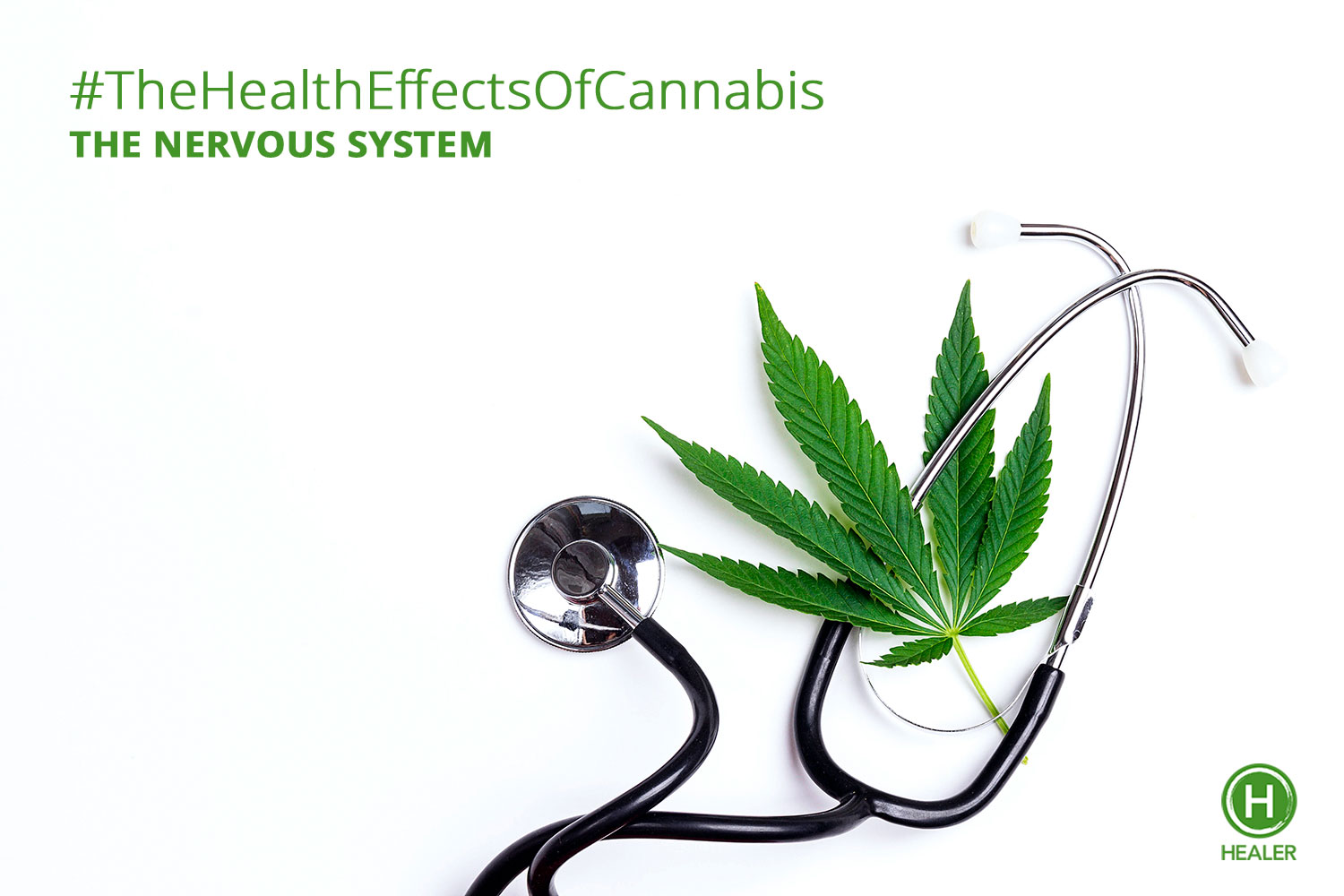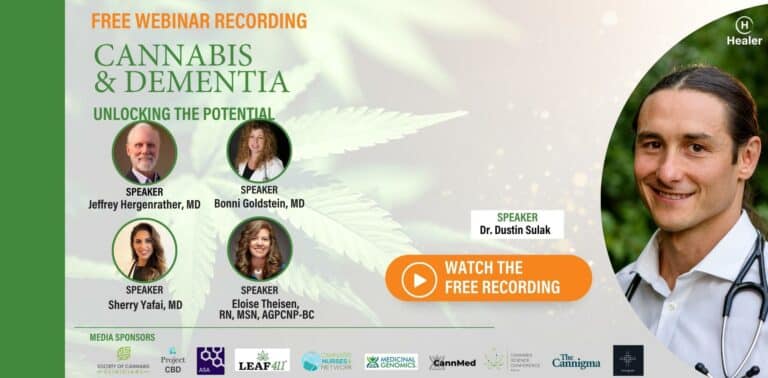Cannabinoids have been shown to reduce the intensity of pain, including inflammatory pain, neuropathic pain, and cancer pain. Cannabinoids reduce spasticity and the pain associated with muscle spasm. Beyond decreasing the intensity of pain, many patients report that cannabis changes the nature of the pain, making it more bearable and less distracting. In certain situations, cannabinoids can increase the intensity of acute pain. Cannabinoids have neuroprotective effects, protecting the nerves from acute injuries like head trauma and stroke, and from conditions that cause chronic injury, such as Alzheimer’s disease. They have anticonvulsant effects, and in some circumstances, antipsychotic effects.
Cannabinoids also affect our consciousness via the nervous system. Depending on the strain or preparation, cannabinoids can be awakening or sedating. Cannabinoids can slow reaction time and cause other changes in sensory perception. Many patients report positive mood, relaxation, laughter, social comfort, time distortion, and the intensification of ordinary experiences (e.g. eating, sex, listening to music) after using cannabis. Cannabis can cause both a dissociative effect (awareness detaching from the physical body and one’s environment) and, conversely, an integrating effect (greater awareness of self and environment).
Abstract: Medical Study
‘The analgesic properties of delta-9-tetrahydrocannabinol.’
Noyes R Jr, Brunk SF, Avery DA, Canter AC.
Abstract
The administration of single oral doses of delta-9-tetrahydrocannabinol (THC) to patients with cancer pain demonstrated a mild analgesic effect. At a dose of 20 mg, however, THC induced side effects that would prohibit its therapeutic use including somnolence, dizziness, ataxia, and blurred vision. Alarming adverse reactions were also observed at this dose. THC, 10 mg, was well tolerated and, despite its sedative effect, may analgesic potential.
Abstract: Medical Study
‘Nabiximols for opioid-treated cancer patients with poorly-controlled chronic pain: a randomized, placebo-controlled, graded-dose trial.’
Abstract
Patients with advanced cancer who have pain that responds poorly to opioid therapy pose a clinical challenge. Nabiximols (Nabiximols is the U.S. Adopted Name [USAN] for Sativex [GW Pharma Ltd, Wiltshire, U.K.], which does not yet have an INN), a novel cannabinoid formulation, is undergoing investigation as add-on therapy for this population. In a randomized, double-blind, placebo-controlled, graded-dose study, patients with advanced cancer and opioid-refractory pain received placebo or nabiximols at a low dose (1-4 sprays/day), medium dose (6-10 sprays/day), or high dose (11-16 sprays/day). Average pain, worst pain and sleep disruption were measured daily during 5 weeks of treatment; other questionnaires measured quality of life and mood. A total of 360 patients were randomized; 263 completed. There were no baseline differences across groups. The 30% responder rate primary analysis was not significant for nabiximols versus placebo (overall P = .59). A secondary continuous responder analysis of average daily pain from baseline to end of study demonstrated that the proportion of patients reporting analgesia was greater for nabiximols than placebo overall (P = .035), and specifically in the low-dose (P = .008) and medium-dose (P = .039) groups. In the low-dose group, results were similar for mean average pain (P = .006), mean worst pain (P = .011), and mean sleep disruption (P = .003). Other questionnaires showed no significant group differences. Adverse events were dose-related and only the high-dose group compared unfavorably with placebo. This study supports the efficacy and safety of nabiximols at the 2 lower-dose levels and provides important dose information for future trials.
PERSPECTIVE:
Nabiximols, a novel cannabinoid formulation, may be a useful add-on analgesic for patients with opioid-refractory cancer pain. A randomized, double-blind, placebo-controlled, graded-dose study demonstrated efficacy and safety at low and medium doses.
Abstract: Medical Study
‘Systematic review: efficacy and safety of medical marijuana in selected neurologic disorders: report of the Guideline Development Subcommittee of the American Academy of Neurology.’
Abstract
OBJECTIVE:
To determine the efficacy of medical marijuana in several neurologic conditions.
METHODS:
We performed a systematic review of medical marijuana (1948-November 2013) to address treatment of symptoms of multiple sclerosis (MS), epilepsy, and movement disorders. We graded the studies according to the American Academy of Neurology classification scheme for therapeutic articles.
RESULTS:
Thirty-four studies met inclusion criteria; 8 were rated as Class I.
CONCLUSIONS:
The following were studied in patients with MS: (1) Spasticity: oral cannabis extract (OCE) is effective, and nabiximols and tetrahydrocannabinol (THC) are probably effective, for reducing patient-centered measures; it is possible both OCE and THC are effective for reducing both patient-centered and objective measures at 1 year. (2) Central pain or painful spasms (including spasticity-related pain, excluding neuropathic pain): OCE is effective; THC and nabiximols are probably effective. (3) Urinary dysfunction: nabiximols is probably effective for reducing bladder voids/day; THC and OCE are probably ineffective for reducing bladder complaints. (4) Tremor: THC and OCE are probably ineffective; nabiximols is possibly ineffective. (5) Other neurologic conditions: OCE is probably ineffective for treating levodopa-induced dyskinesias in patients with Parkinson disease. Oral cannabinoids are of unknown efficacy in non-chorea-related symptoms of Huntington disease, Tourette syndrome, cervical dystonia, and epilepsy. The risks and benefits of medical marijuana should be weighed carefully. Risk of serious adverse psychopathologic effects was nearly 1%. Comparative effectiveness of medical marijuana vs other therapies is unknown for these indications.
Abstract: Medical Study
‘Cannabinoids and brain injury: therapeutic implications.’
Mechoulam, Raphael, David Panikashvili, and Esther Shohami
Abstract
Mounting in vitro and in vivo data suggest that the endocannabinoids anandamide and 2-arachidonoyl glycerol, as well as some plant and synthetic cannabinoids, have neuroprotective effects following brain injury. Cannabinoid receptor agonists inhibit glutamatergic synaptic transmission and reduce the production of tumour necrosis factor-alpha and reactive oxygen intermediates, which are factors in causing neuronal damage. The formation of the endocannabinoids anandamide and 2-arachidonoyl glycerol is strongly enhanced after brain injury, and there is evidence that these compounds reduce the secondary damage incurred. Some plant and synthetic cannabinoids, which do not bind to the cannabinoid receptors, have also been shown to be neuroprotective, possibly through their direct effect on the excitatory glutamate system and/or as antioxidants.
Abstract: Medical Study
‘Dose related risk of motor vehicle crashes after cannabis use.’
Ramaekers, Johannes G., et al.
Abstract
The role of Delta(9)-tetrahydrocannabinol (THC) in driver impairment and motor vehicle crashes has traditionally been established in experimental and epidemiological studies. Experimental studies have repeatedly shown that THC impairs cognition, psychomotor function and actual driving performance in a dose related manner. The degree of performance impairment observed in experimental studies after doses up to 300 microg/kg THC were equivalent to the impairing effect of an alcohol dose producing a blood alcohol concentration (BAC) >/=0.05 g/dl, the legal limit for driving under the influence in most European countries. Higher doses of THC, i.e. >300 microg/kg THC have not been systematically studied but can be predicted to produce even larger impairment. Detrimental effects of THC were more prominent in certain driving tasks than others. Highly automated behaviors, such as road tracking control, were more affected by THC as compared to more complex driving tasks requiring conscious control. Epidemiological findings on the role of THC in vehicle crashes have sometimes contrasted findings from experimental research. Case-control studies generally confirmed experimental data, but culpability surveys showed little evidence that crashed drivers who only used cannabis are more likely to cause accidents than drug free drivers. However, most culpability surveys have established cannabis use among crashed drivers by determining the presence of an inactive metabolite of THC in blood or urine that can be detected for days after smoking and can only be taken as evidence for past use of cannabis. Surveys that established recent use of cannabis by directly measuring THC in blood showed that THC positives, particularly at higher doses, are about three to seven times more likely to be responsible for their crash as compared to drivers that had not used drugs or alcohol. Together these epidemiological data suggests that recent use of cannabis may increase crash risk, whereas past use of cannabis does not. Experimental and epidemiological research provided similar findings concerning the combined use of THC and alcohol in traffic. Combined use of THC and alcohol produced severe impairment of cognitive, psychomotor, and actual driving performance in experimental studies and sharply increased the crash risk in epidemiological analyses.
© 2024 Healer. All rights reserved.
Site by CannaPlanners





